ROME AND TUSCANY
May 10-24, 2014

THE BIG PICTURE
We flew from Denver to Charlotte (NC) and on to Rome
where we stayed
near the Colosseum for five days. We took a train (and a bus and
another train) to Siena where we settled into La Flora B&B just
outside the city and rented a car to visit as many hill towns in
Tuscany as we could in the next six days. We returned to Rome by bus
and spent another night before flying back to Denver via Charlotte. In
all, we flew about 10,000 miles, drove 1,000 miles across the Tuscany
landscape, and completed about 60 miles of urban hiking. It was our
second trip to Italy (our first in 2007 to
Venice, Florence, Milan, and
Cinque Terre) and we could happily return for a third visit to
this beautiful and historic country.
I. ROME
 Our grandson had spent the
spring semester living in Rome studying history, art, architecture as
well as traveling to historic sites from Venice to Sicily. His last day
was May 9, so we tagged along with this parents and sister to celebrate
completion of his studies and take advantage of his knowledge of Roman
history and art. Unfortunately he did not study the language—he is
majoring in Classics and his languages are Latin and Greek—nor did he
have the luxury of spending time in fancy restaurants. As a result, we
stumbled along with gestures and a few key phrases, and confined our
dining choices to surprisingly fine neighborhood trattorias and small
restoranti.
Our grandson had spent the
spring semester living in Rome studying history, art, architecture as
well as traveling to historic sites from Venice to Sicily. His last day
was May 9, so we tagged along with this parents and sister to celebrate
completion of his studies and take advantage of his knowledge of Roman
history and art. Unfortunately he did not study the language—he is
majoring in Classics and his languages are Latin and Greek—nor did he
have the luxury of spending time in fancy restaurants. As a result, we
stumbled along with gestures and a few key phrases, and confined our
dining choices to surprisingly fine neighborhood trattorias and small
restoranti.
We based ourselves for five nights at the Hotel Capo
D’Africa just a few blocks from the Colosseum and near a metro stop
in
a quiet urban neighborhood. Each day we explored new areas of this
historic and beautiful city of nearly three million people.
[Note:
The history of Rome allegedly began in 753 BCE as a kingdom ruled by
Romulus, then became a Republic in 509 BCE, and finally an Empire in 27
BCE (Augustus is the first Cesar) which lasted until 476 CE when the
last Cesar, Romulus Augustulus, was
overthrown by Germanic troops led by Odacer, who is proclaimed (by his
troops) King of Italy. Of course people lived in the area before
Romulus and Remus, and have continued to live since the fall of the
Empire. Hence, the nickname “The Eternal City.” For more, I suppose you
might read Edward Gibbon who can fill in lots of the details.]
•The Colosseum
Our first stop was to the nearby Colosseum
which we
could almost see from our hotel. We tried to beat the crowds by getting
there before 9:00 am, but school groups and guided tour groups, each
with their easily identifiable colored hats or scarves or badges or
T-shirts had clustered here and there waiting for the 9:00 o’clock
opening. [Note:
Admission is €15.50, about US$21.] The souvenir sellers were
already set up and doing business. In spite of the early crowds, we
never felt rushed and with the help of our recently graduated grandson,
we learned some of the history of what is officially the Flavian
Amphitheatre. It was built on the site of the palace of the much hated
Nero; construction began in 72 CE and was completed eight years later.
The huge arena seated an estimated 50,000–70,000 and was used to host
spectator “entertainments” featuring combat between gladiators—usually
slaves, prisoners, condemned criminals, including a few women—plus
animals, Christians and non-Christians. During the opening days in 80
CE, over 9,000 wild animals (exotic and dangerous ones trucked in from
across the Empire, especially Africa) were killed. Massacre was the
aim, blood on the ground was the objective, and the audience got what
they paid for. As the Empire became more Christianized, the death of
humans gradually came to an end. But not animals.
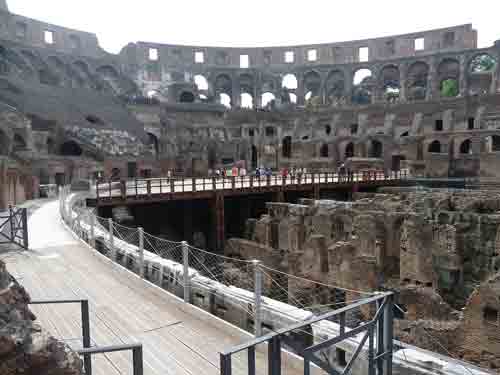
We were surprised to learn that naval battles also
were held in the Colosseum using real ships which required flooding the
stadium. Once the galleries in the basement areas were built, such
spectacles were moved to other, smaller stadiums.
Like much of the rest of Rome, the Colosseum is
undergoing massive renovation as befits one of Rome’s many World
Heritage Sites. In fact, since the decline of the Empire, the
building
has fallen into disuse and disrepair. For centuries it had been
literally falling apart and ignored along with so many other ruins in
this ancient city. Marble slabs were removed from the exterior (which
accounts for the large holes in this and other ancient buildings), the
arena became a muddy swamp, earthquakes shook loose stone blocks that
were scooped up and taken to other parts of the city for private use,
and for generations thieves and prostitutes are said to have squatted
throughout the tunnels and galleries.
Not until the mid-19th century was there any
enthusiasm (or money?) for renovation. Parts of the structure today are
off-limits, perhaps because they are unsafe or undergoing
reconstruction. Scaffolding is big business in Rome and there is
probably more work than there are funds and fewer workers to do what
needs to be done. However, major restoration is clearly underway to
save the city’s most famous symbol.
Adjoining the grounds of the Colosseum is the Arch
of Constantine commemorating the victory of Constantine I at
the Battle
of Milvian Bridge in 315 CE. It’s actually made up of three arches
decorated with scenes of the battle etched in the marble face. Statues
representing Constantine I and, it is said, of some unnamed prisoners
stand on pedestals than adorn both sides of the Arch. The Arch is
complex and deserves more than a passing glance to fully appreciate the
history, the art, the architecture, and the beauty represented in this
huge structure.
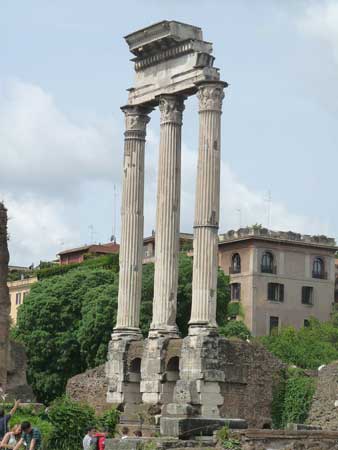
•A
Walk Down the Roman Forum
The Forum
was a place where people gathered, to
talk, to do business, to share gossip, to give or to hear speeches—in
short, it was Rome’s town square or Central Park without the joggers
and drug deals going down. It was the central area of the city around
which the town grew. The Forum spreads out from the base of the
Capitoline
Hill, the smallest of Rome’s seven hills but perhaps the
most important: it was here the first nucleus of the city grew. The
Capitoline was a ceremonial center and a religious center. Here were
temples to the Roman Gods, especially the Temple of Jupiter, to keep an
eye on what was going on below in the Roman Forum. Today the star
attraction is the Piazza
del Campidoglio, designed by Michelangelo in
the 16th century.
The forum grounds in time were surrounded by large
public buildings that confined the forum to an area about 450' by 160'.
Walking from the Arch of Constantine through the rubble and ruins of
once beautiful structures, we saw where the Temple
of Vesta once stood
until 1549 when it was demolished and its marble recycled in other
palaces and churches. What’s there today was reconstructed in the
1930s.
Many of the oldest and most important buildings in
Ancient Rome were located in or near the Forum, though most are rubble
or mere fragments scattered about. The remaining three columns of
Temple of Castor and
Pollux stand proudly and starkly against the
apparent hodgepodge of what used to be the center of a huge and
powerful empire.
Continuing our walk through the Forum led us to the
Victor
Emmanuel II Monument, the tallest and arguably the most
distinctive building in the city. It is perhaps the whitest structure
in the city, often referred to as the “wedding cake.” Two bronze quadrigae (chariots) stand atop two
corners of the building that houses a museum dedicated to the
unification of Italy in 1861 with Victor Emmanuel II as its first king.
A huge equestrian statue of himself as “Father of the Nation” stands
prominently in the front.
[Note:
Walking from the Colosseum to the Victor Emmanuel II Monument can take
the better part of a day. You have to visit a side street for a meal or
refreshment or to visit one of the few very hard to find public WCs.
(There may be a charge, so be sure to have a Euro in change ready to
buy your way in.) We did the walk without lingering very long at any
one spot and felt we had seen enough marble statuary and other ruins
for one day. You may decide to dedicate yourself to a closer inspection
of the area by spending two days in the area. We had time constraints,
like most tourists, and we had a reservation at the Vatican in the
morning. We kept moving on.]
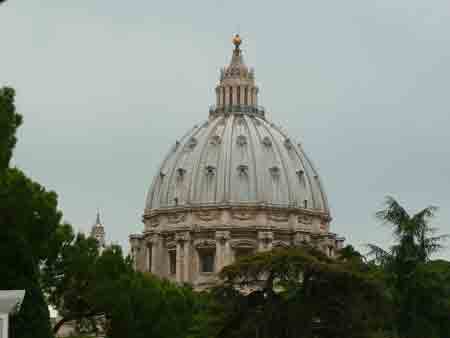
•The
Vatican
If the Colosseum is the symbol of (Ancient) Rome,
the Vatican is, well, the Vatican. It is the head and heart of this
smallest independent country/city state and the seat of the Roman
Catholic Church worldwide. Its buildings take up 90% of the 110 acres
that comprise what seems like a tiny “neighborhood” surrounded by the
megalopolis of Rome. The Pope, church officials, librarians, postal
workers, Swiss guards, groundskeepers, and everyone that has to do with
running church business works there. Only 840 people live in Vatican
City State (the official governmental designation) so most who work
there have to commute.
The usual tour taken by most visitors includes the
Vatican Museums
and the Sistine
Chapel [Note:
Tickets are
€16.00 = about US$22 which may be purchased online to avoid lines]
though there are additional options: e,g., Vatican Gardens, Barberini
Garden, et al.) Before you go, you can prepare yourself with a visit
the Museum’s collections with a Virtual
Online Tour.
[Note:
The last Sunday of each month the Museum is open to the public for
free. Lines are long and so is the waiting time.]
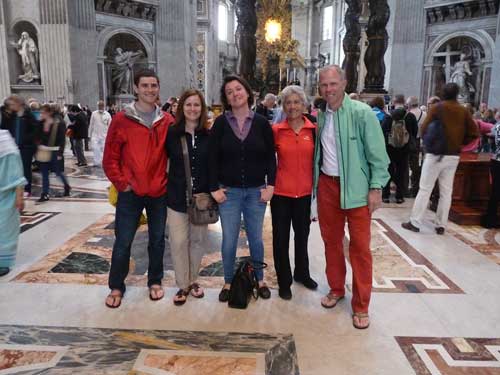 We went one step further, thanks to our daughter’s
foresight and good planning: she hired a guide, Agnes from England, to
lead our tour of five through the Museums and into the Sistine Chapel.
Agnes works with Context Travel
and she was terrific. She did not show
us everything, but focused on what she thought was most interesting (or
what she knew the most about or what she thought, based upon previous
groups, we might be most interested in.) However, she answered all our
questions about anything we wanted to know. She kept a good pace to
maximize our time (about three hours), had a good sense of humor, and
showed us, we believe, the highlights. It was a good tour and we
recommend this way of getting the most from the experience. You could
opt for a recorded tour (and many people obviously did), but Agnes was
stimulating and provocative in a way a recorded tour can’t be.
We went one step further, thanks to our daughter’s
foresight and good planning: she hired a guide, Agnes from England, to
lead our tour of five through the Museums and into the Sistine Chapel.
Agnes works with Context Travel
and she was terrific. She did not show
us everything, but focused on what she thought was most interesting (or
what she knew the most about or what she thought, based upon previous
groups, we might be most interested in.) However, she answered all our
questions about anything we wanted to know. She kept a good pace to
maximize our time (about three hours), had a good sense of humor, and
showed us, we believe, the highlights. It was a good tour and we
recommend this way of getting the most from the experience. You could
opt for a recorded tour (and many people obviously did), but Agnes was
stimulating and provocative in a way a recorded tour can’t be.
There are several collections within the Museum that
span the ages from early Greece and Egypt to the 20th century, and,
with the changing of special exhibits, represent virtually all cultures
from Faberge eggs and icons to Aboriginal art forms. These special
exhibits are free with the regular museum tickets.
It would be difficult and unfair to single out any
one or two works of art from the thousands within the collection.
However, it is safe to say that Michaelangelo’s Pieta and his ceiling of the
Sistine Chapel draw the largest and longest standing crowds. That said,
Giotto’s Stefaneschi Altarpiece
is worth a long and careful study, and Laocoon and his Sons shows how
a
sculpture can come alive before your eyes. While most folks’ eyes glaze
over passing through the map gallery, fortunately there is room for
those of us who wish to study each of them carefully without blocking
traffic.
The small gift shop we passed by when we finished
the tour has all the usual books and souvenirs (including Pope
bobblehead dolls!!). We bought postcards and went next door to the
Vatican post office and bought stamps and mailed them. [Note:
A postcard stamp to the USA is €2.00 = US$2.75.] The few stamps
left over we learned could be used to mail cards from outside the
Vatican, though we don’t know how far away they will be accepted.
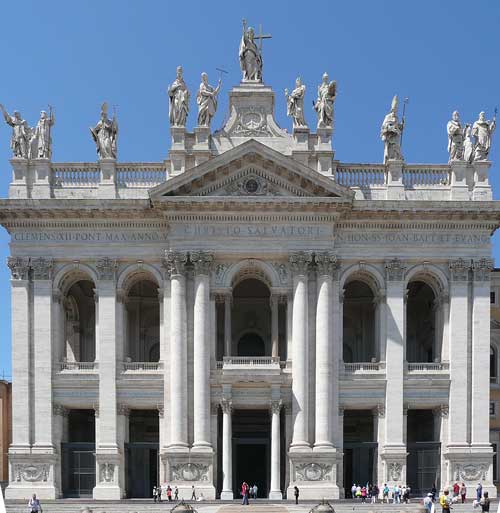
•Basilica
of San Giovanni in Laterano
Grandson Griffin was especially insistent that we
should visit this most ancient church in the world (built in 311–314
CE), just a short, but uphill, walk from our hotel. Since it was the
first church built in Rome (first church in the world?), it was and
still is Rome’s cathedral and the residence of the Bishop of Rome.
Originally a first century mansion belonging to the Laterani family,
Nero converted it to a military barracks. Constantine razed the
barracks and rebuilt the church on that spot. The church was, in fact,
the residence of Popes until the papacy returned from exile in Avignon
in 1377. Over the years invading Visigoths ravaged the building, as did
the Vandals in the 5th century; earthquakes did damage as did great
fires in the 9th and 14th centuries. Each time disaster struck, the
church acted promptly to repair and restore the building and the art
treasures within. The result today is an outstanding representation of
Baroque architecture completed in 1735.
We found St John Lateran beautiful in all respects.
The first thing you might notice on the exterior of the east entrance
are two huge bronze doors that were taken from the Imperial Forum, and
across the top of the entrance eleven figures with Christ in the
middle, with co-patrons John the Baptist and John the Evangelist on
either side.
[Note:
Who the remaining eight statues represent is in some dispute. Some
sources say they are important church figures, other sources say they
are saints, and others claim they are apostles, though that brings the
total number of apostles to ten.]
 The interior is imposing and lavishly decorated; it
compares well with St. Peter’s, though without as many major art pieces
as found in the Vatican. Magnificent larger than life statues of the
twelve apostles by various 18th century sculptors fill niches in the
walls surrounding the nave. Tombs of early popes are placed around the
edges of the nave, the ceiling is beautifully complex and richly
decorated, the patterns in the floor are reminiscent of those in St
Peter’s, and sitting along on the back wall of the altar is the Pope’s
marble throne to be used only by him. The church claims to house two
significant religious relics: the cedar table said to be the one used
at the Last Supper, and a sample of Christ’s blood.
The interior is imposing and lavishly decorated; it
compares well with St. Peter’s, though without as many major art pieces
as found in the Vatican. Magnificent larger than life statues of the
twelve apostles by various 18th century sculptors fill niches in the
walls surrounding the nave. Tombs of early popes are placed around the
edges of the nave, the ceiling is beautifully complex and richly
decorated, the patterns in the floor are reminiscent of those in St
Peter’s, and sitting along on the back wall of the altar is the Pope’s
marble throne to be used only by him. The church claims to house two
significant religious relics: the cedar table said to be the one used
at the Last Supper, and a sample of Christ’s blood.
Only Griffin and Julia visited the Cloisters which
are the remains of an early 13th century Benedictine monastery. The
quiet garden-like setting is surrounded by double columns of inlaid
marble. A porphyry slab within the cloister is believed to have been
used by Roman soldiers casting lots for Christ’s robes.
When the papacy returned to Rome from Avignon, the
city was virtually deserted and they moved into St. Peter’s instead of the
Lateran. However, St. .John Lateran remains the Cathedral of the
Church of Rome, the mother church among all Roman Catholic Churches,
ranking even above St. Peter’s Basilica. An excellent online virtual
tour of the church highlights and explains many of the specific
features of the building.
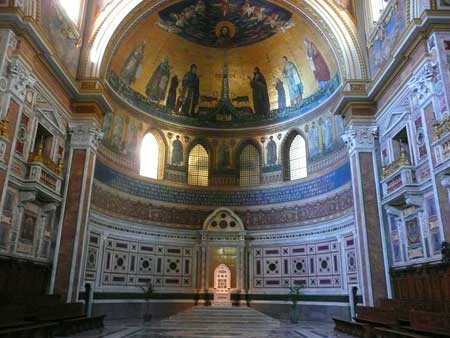
[Note:
We kept reading about churches, basilicas, and cathedrals and wanted to
clarify the differences.
•Church. Any house or place of worship
by any Christian denomination.
•Cathedral. Home church of the bishop of the
diocese and the location of the bishop’s throne, usually set on a
raised platform. The Latin word for raised chair or throne is cathedra,
hence the English cathedral.
•Basilica. This is a bit more complicated since a
church and a cathedral may be a basilica but under only under certain
conditions. A basilica may refer to a church built in a particular
style, or to a hierarchy of churches identified by the Roman Catholic
Church: Major basilicas, of
which there are only four, are all in Rome and are granted certain
vaguely defined privileges; and Minor
basilicas, about 1600 around the world, are granted certain other
privileges of a more specific nature.]

•Other Major Sites (Briefly Noted)
•Spanish
Steps. Why did this become a must-see location in Rome?
Granted
it’s a good place to sit for a rest, if you don’t mind sitting with the
trash that collects daily; if you don’t mind the noise of hundreds of
other folks sitting, smoking, necking, or eating; if you want to ogle
pretty girls or good looking guys. We thought it a waste of time except
it gave us all a chance to check it off our list of places to visit.
•Bernini’s Elephant
Statue. In the Piazza della Minerva just outside the church
of
Santa
Maria sopra Minerva, is an unusual statue of an Egyptian obelisk
standing upon a marble elephant designed by Bernini in the 1660s. It’s
interesting to look at, but not to linger over. (Despite graffiti
everywhere in Rome, there is none on this sculpture—maybe none in over
350 years!)
•The Pantheon.
This downtown landmark was originally built as a temple at the command
of Emperor Hadrian between 118–125 CE and dedicated to the Roman Gods.
Unlike its Greek counterpart, the Parthenon, Rome’s Pantheon is
enclosed with great bronze doors that were originally covered with
gold. Students of architecture especially will appreciate the geometric
design of the building with walls of varying weight supporting the dome
of intersecting arches. Today it is used as a church; Italian kings
Emanuele and Umberto are buried there as well as painter Raphael. It is
definitely worth a visit. 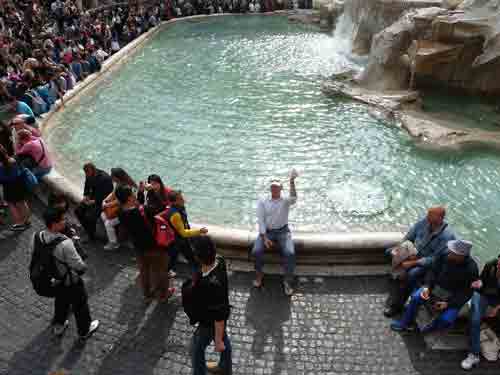
•Trevi Fountain.
Remember the gaggle of looky-lous at the Spanish Steps? Sometime during
the day they all moved en mass
to the Trevi Fountain where they took as
many selfies as they could before their batteries ran out. To be sure,
the Trevi is the largest and one of the loveliest fountains in Rome.
Created by sculptor Nicola Salvi who based his design on one by
Bernini, it was completed in 1762. The prominent figure of Neptune
rides a shell-shaped chariot pulled by two sea horses. The origin of
the tradition of throwing a coin into the fountain (tossed with your
right hand over your left shoulder, or vice versa, without looking
back; we don’t know what happens if you throw the coin with the same
hand as the shoulder!) is lost in the fog of history and revived in the
1950s movie
“Three Coins in the Fountain” and the popular 1960s Italian movie “La
Dolce Vita.” An estimated €3,000 winds up in the bottom every day,
which is reportedly given to Rome’s needy people.
Another impressive fountain that isn’t surrounded by
quite so many visitors is the spectacular Four Rivers Fountain
in the center of Piazza Navona. Designed by both Bernini and Borromini,
it is considered one of the finest Baroque Sculptures in Rome. We
lingered over cappuccinos and wine at the Caffe Domizian
(see photo below), enjoying the
fountain while watching the parade of locals and tourists passing by.
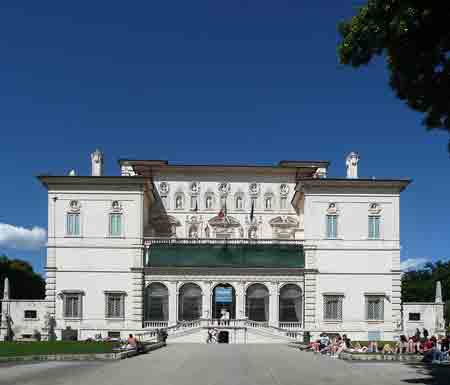 •Borghese
Gardens. This 148-acre park is an oasis of quiet beauty
surrounded by the hubbub of the city. It is used by runners and
bicyclists, folks with picnics or books, and those who simply want to
relax under the shade trees that cover the grounds. Originally a
vineyard, Cardinal Scipione Borghese began developing the garden in the
early 1600s and informally opened it to the public. The city of Rome
purchased the grounds in 1903.
•Borghese
Gardens. This 148-acre park is an oasis of quiet beauty
surrounded by the hubbub of the city. It is used by runners and
bicyclists, folks with picnics or books, and those who simply want to
relax under the shade trees that cover the grounds. Originally a
vineyard, Cardinal Scipione Borghese began developing the garden in the
early 1600s and informally opened it to the public. The city of Rome
purchased the grounds in 1903.
Several villas remain within the Gardens, the most
prominent being the Villa
Borghese (on left) which houses an excellent collection
of paintings (Caravaggio, Titian, Raphael, and Rubens among others) and
sculptures (many by Bernini, including the magnificent “Apollo and
Daphne,” “Rape of Proserpine,” and his rendering of “David,” and
Canova’s masterpiece “Pauline Bonaparte”). [Note:
Tickets run about €11
(US$15) and well worth the investment.]
•The Ara Pacis
Museum. This modern building was constructed especially to
house
and preserve the Altar of Peace built in 9 BCE. The altar itself is
surrounded by marble walls with friezes depicting historical figures.
On a hot day, the air conditioned building is a comfort. Avid
historians may appreciate the displays. [Note:
Tickets are €8.50 = UD$11.50.]
•National
Etruscan Museum. Though the Etruscans
left their name on the map
(Tuscany) before they disappeared, not very much is known for certain
about this early civilization that settled central Italy. Their art
seems very much indebted to the arts of Greece. Ancient history lovers
will appreciate the many important artifacts shown and described in
this collection. It is housed in another of the villas in the Borghese
Gardens, the Villa Giulia. [Note:
The price of admission is €4 (US$5.50)] If you know your
Etruscan history, you’ll enjoy your visit.
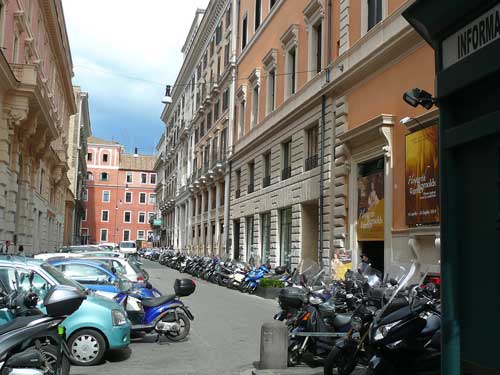
•Geocaching in
Rome. Before we left on the trip, we downloaded to our GPS
locations of ten geocaches in Rome and found nine of them. Some were
easy pickings, some were downright tricky, and one was likely muggled.
In fact, with all the visitors and relatively easy access, it’s a
wonder any were left for us at all. Each of them was a micro so we were
unable to leave a trackable at any of them. Too bad. Builder Bob came
home with us and we’ll have to place him around here. We did take
photos of him at most of the geocache sites so there’s a record of his
travels.
[Note:
Many people deal with Rome’s horrific traffic by using scooters and
smart cars.]
•Eating,
Dining, and Drinking in Rome
When in Italy, eat Italian. This sounds
self-evident, but some tourists are tempted by MacDonald’s fast food
joints, a handful of Chinese restaurants, even an Irish pub/restaurant.
Some of the swanky spots likely offer high priced French cuisine and
other exotic foods. But why bother when every neighborhood
restaurant/trattoria/pizza place serves up great pasta dishes, roasted
veggies, pizza, meat entrees, and tasty desserts at very reasonable
prices? To our delight, we had a dozen or more small neighborhood
eating places from which to choose. Two were memorable: Taverna Dei Contrari and Hosteria Isidoro, both near the
Colosseum, both offer excellent food, both had fine service, neither
needed a reservation, and we would go back again. (In fact we did eat
twice at Taverna Dei Contrari and they welcomed our return like
family. We reviewed both restaurants for TripAdvisor.)
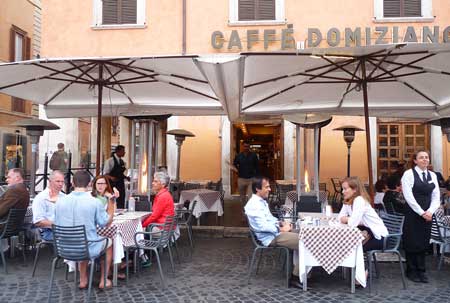
We tasted wines from various regions (Chianti, Vino
Nobile, Brunello, etc.) but found that for €2.50/glass, the house reds
wherever we ate were much more to our liking that the €20/bottle. The
beers, almost exclusively Peroni and Moretti, are superior to Bud,
Miller, and many handcrafted American beers. And cheap.
Almost any break in the morning or afternoon or
evening is a good time for a cappuccino, that flavorful, frothy
expresso and milk drink that tastes good wherever you find it. (In the
photo left, we are relaxing with a cappuccino across from the Four
Rivers Fountain after a long day of urban hiking.) Every
cafe, restaurant, and bar in Italy must use the same recipe and
ingredients. It’s wonderful.
II. ARRIVEDERCI ROMA, CIAO TUSCONA
We purchased one-way tickets for Siena at the Rome
train station. We had no difficulty making the purchase from a machine.
[Note:
We did not run into any panhandling, pickpocketing, or any real
dangerous activities the entire trip. However, there are a few common
annoying scams practiced all over Rome. There’s the guy who wants to
give you a rose—”Free to you because you’re so beautiful” and then
hounds you to give him some money. How much? We don’t know since we
never took one. At the train station we bumped into another scam: When
you’re getting your ticket from the machine, a guy comes along and says
he can help work the machine. Where are you going? Do this, do that,
and out comes the tickets. He did it. No problem. Thanks very much.
Then his hand goes out for some sort of vague payment—a tip? a
donation? a gesture of appreciation? There was some change left over,
less than one or two euros, which Judy gave him. He looked at it and
gave it back. Not enough, apparently. How insulting. Jeez!! It’s better
to say, “No, grazie,” politely but firmly and move on.]

The train left on time (you can count on that
happening in Italy) and took us as far a Grosetto (we think) where we
had to get off the train—”This is as far as this train goes!”—and
waited for a local bus which took us via some rural roads (nice
scenery, but slow) as far as Buonconvento where we had to get off and
wait for a three-car local train to Siena. We don’t know if we could
have found out beforehand if there was another scheduled train-only
trip. We took an express bus on the return trip to Rome.
We learned that afternoon that there are very few
taxis in Siena, a city of about 55,000. We waited a good 30-40 minutes
at a fairly busy corner in town before we were able to flag one down to
drive us about eight miles to our home for the next week: B&B
La
Flora. Valerio welcomed us and showed us our bedroom and the
dining
room, with a refrigerator and table spread with pastries and crackers.
We unpacked and strolled outside through their olive orchard and their
vineyard to an overlook of Siena to the north and west. It had been a
long day and we were tired. We had not let Valerio and Elisa know in
advance that we would like a dinner that evening, so we ate our cheese
and bread and drank wine in the grassy patio. We spent the time before
it got dark planning our week in Tuscany. It was a very pleasant way to
finish off what had been a day of surprises and minor frustrations.
We talked with Elisa when she came home that evening
from work (they both work full time for technical service companies in
Siena: Valerio for the city, Elisa for a private company). She welcomed
us and before our conversation was over, we had some good ideas for day
trips, where to eat in Siena, and an offer, gladly accepted, to take us
in the morning to pick up our rental car which, it turns out, is not
far from where she works. Breakfast was cereal, fruit, yoghurt,
pastries, toast, and coffee or tea. We joined the other four guests who
were from Italy and spoke limited English, though one couple stayed
four days and we got to know them pretty well; Claudio understood more
English than he spoke, and Serena spoke English, but not as well as her
German and French and Italian. Our limited language skills were a
trifle embarrassing.
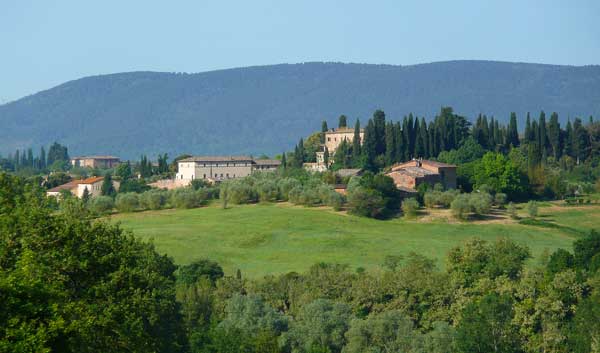
We left with Elisa in the morning to pick up our
car and began our day trips of Tuscany.
•The Chiantigiana Road
Just north of Siena, route SS222 is a scenic drive
through the heart of Chianti wine country. It is a loop that we began
in Siena, then north to Castellina in
Chianti, on to Greve
in Chianti,
then south to Radda
in Chianti and Gaiole in Chianti,
and back to
Siena. It is certainly one of the most beautiful regions of Italy and
the drive was as good as the travel guides described. It’s unlikely a
month goes by that some travel magazine doesn’t write a feature this
area of green, rolling hills, attractive hill towns that beckon you to
stop, and wineries inviting you to come taste their particular Chianti
Classico. The rural roads are strictly two-lane, twisty in some
places,
well lined, clearly marked with roadsigns, and smooth. It’s as though
the highway department intentionally tried to provide comfort to the
drivers as well as slow down traffic so that we could truly enjoy the
scenery.
[Note:
While we were on our trip, the 2014 Giro d’Italia, one of the three
premier bicycling races along with the Tour de France and La Vuelta a
Espana, started this year in Belfast and moved to Dublin before
transferring riders to Giovinazzo in southern Italy. The route passed
north through the heart of Italy, into the Dolomites and ended in the
Trieste three weeks later. Oddly, we saw little about it on Italian TV
or in newspapers (soccer remains by far the most popular sport) but we
did notice many groups of local bike riders, and some touring
individuals and pairs, on the back roads every day.]

In many respects the major towns along the route
are very much similar to each other in size, layout, and services. In
Castellina we stopped to shop in a local outdoor day market that
featured fresh produce, clothing, hardware, and household items. We
found the same sort of market spread out in the central piazza in Greve
where we shopped a bit more and then enjoyed a light lunch and
cappuccino
at Caffe le Logge on the
square. We completed our loop south through Radda and Gaiole and
returned to home in the early evening.
There are, of course, vineyards everywhere—except
where olive trees grow, though often we found them almost together—and
many tasting opportunities throughout the region (reservations
recommended). There are many estates that offer for winery tours,
classes and seminars on the wines of this and other regions and to
learn how to be a more discriminating wine drinker. Strictly on our own
we tried several Chianti Classico wines (i.e., premium Chianti wines
from a particular subregion of Chianti and designated by the gallo nero
[black rooster] logo found on these select wines. Standard Classico is
labelled with a red border; Riserva Classico has a golden border and
identifies wine produced from the best grapes and aged at least 27
months.) Perhaps our taste for wines lacks sophistication and
sensitivity, but we were not persuaded to purchase any bottles at any
price, and the range of prices seemed to have no upper limits. A class
on how to judge, what to look for, and how to overlook how the wine
tastes would have helped. We continued to return to the house reds when
we had choices. No matter. We loved the countryside where the grapes
are grown and where the wines are produced.
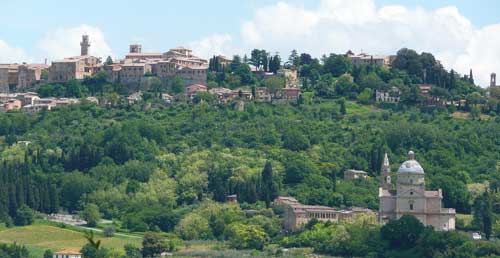
•Hill
Towns �South of Siena
•Montepulciano.
We drove south out of Siena to Asciano, through Trequanda where stopped
for a cappuccino at a small cafe across from the church and explored
some of the narrow streets and wondered what life would be like living
here.
About 12 miles further we came to Montepulciano,
which turned out
to be a charming medieval/Renaissance town of about 15,000,
strategically placed on a hill overlooking the Val di Chiana (Valley of
the River Chiana). The walls date from the 14th century and there is a
360° view of the region. It was first settled by the Etruscans at
least as early as the 4th century BCE before Rome dominated the region.
After the fall of Rome, the town was conquered alternately by Siena,
then Florence, then Siena and back again, with city-states Orvieto and
Perugia getting into the action on behalf of Montepulciano. The cathedral
is from the 17th century based upon a Latin cross design with a
massive, if plain, exterior of travertine and brick. The interior
features paintings, sculptures, and a monumental triptych by di
Bartolo. The Church of St. Augustine with its sculptured exterior and
bright interior is also worth visiting.
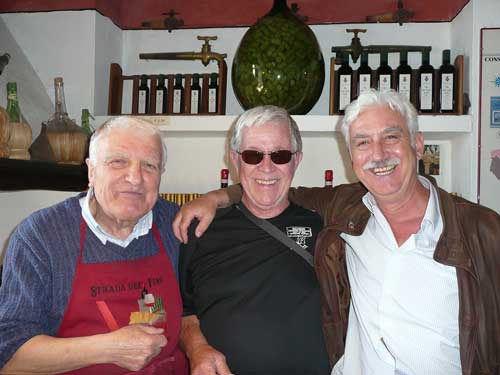
The narrow cobblestone main street passes by
attractive shops, the duomo, a clock tower, and other places of
business. This car-free mile-long street is known as “Vino
Nobile
Montepulciano Wine Route” because of the many stops along the way
where
visitors may sample different versions of this “noble wine” as well as
local cheeses. We stopped at the wine store of Amado, who was a
delight, and more interested in meeting and talking with people (mostly
in
Italian) than in selling the wines he had out for tasting. He was happy
to have us sample several of his wines and tour the cellars where he
kept the barrels of aging wines.
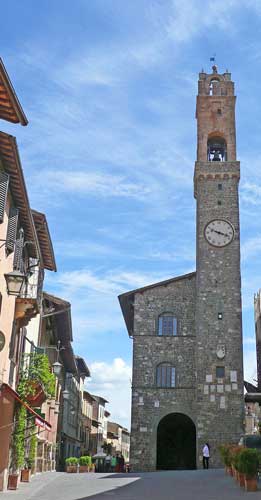
[Note:
On the last Sunday in August, a barrel rolling race is held in which
eight men, representing the eight town districts, roll wine barrels
weighing 80 kilos (176 pounds) up the steep, twisting, narrow streets
ending in the main square where prizes are awarded followed by a feast
for the town lasting late into the night.]
On our way out of town, we visited the Tempio
di
San Biagio (Sanctuary of San Biagio), a spectacular church below
the
town and outside the walls of Montepulciano. It was constructed in the
16th century in a Greek cross plan using designs from St. Peter’s and
the Brunelleshi’s dome in Florence. The interior seems smaller than the
outside would indicate and there was a good deal of renovation and
construction going on both outside and within.
•Montalcino.
West from San Biagio we passed fields not only of grapes and
olives, but of sheep who don’t know how good they have it, surrounded
by lush green fields and protected by dozing shepherds from marauding
village dogs and cats. It should be acknowledged that the tastiest
cheese we had in Italy was sheep cheese, something we don’t find often
here.
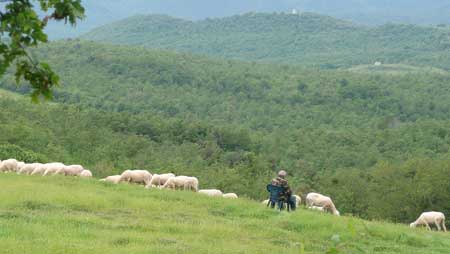
Montalcino is a hill town is famous for its Brunello
di Montalcino wine, something we sampled here at home before we left
and did not particularly care for. Of course there are several
varieties and estates and, therefore, different tastes. Given its
reputation, we thought we should go to the source. The reputation and
popularity of the Brunello wine has kept this town financially afloat:
eleven producers in 1960 has grown to over 200 estates today that
produce this award-winning wine.
While we still didn’t love the samples we tried, we
discovered a beautiful medieval walled town of about 5,000 folks whose
ancestors held off both Florentine and Sienese armies longer than
expected and finally caved in to the Florentines in the mid-16th
century. The town has also prospered as a destination for tourists,
both local and foreign: the beauty and culture of the town, the many
festivals held here in an authentic medieval atmosphere, as well as the
fame of the Brunello wines, keep visitors coming. Like each of the
hilltop towns in Tuscany, the greatest pleasure we had was walking
leisurely through the narrow cobblestone streets enjoying the feeling
of neighborhood and the play of light and shadow on the buildings and
side streets.
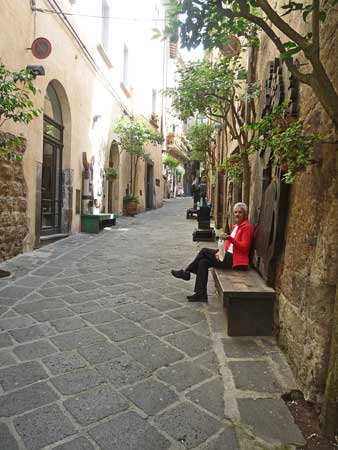
•Murlo.
It was first thing in the morning when we visited this tiny, walled
hill town recommended by a friend who had traveled to Tuscany a few
years ago. She said she so enjoyed her visit to Murlo, which is out of
the way but worth the side trip. Like Montalcino, Murlo is small (all
sources say there are about 2,000 residents, but it seemed to us more
like
200), protected by imposing stone walls and isolated atop a 1,000'
hill. It was founded in the 12th century, but with its origins going
back to the Etruscans who left evidence of their presence in statuary
and artifacts that go back some 3,000 years. The Antiquarium Museum
contains Etriuscan statues, tools, and other evidence from excavations
that continue.
Murlo is certainly not a tourist destination, though
there are some buses that go there. We were early getting to the town
which seemed almost deserted at 10:30 am. There were a few restaurants,
though none open at the time we were there, and we felt as though we
had the whole town to ourselves to explore and find out what was around
each corner. This really was a step back in time to the Middle Ages (if
you ignore the satellite dishes scattered about the buildings and the
two cars we saw) and we’re glad we made the trip there.
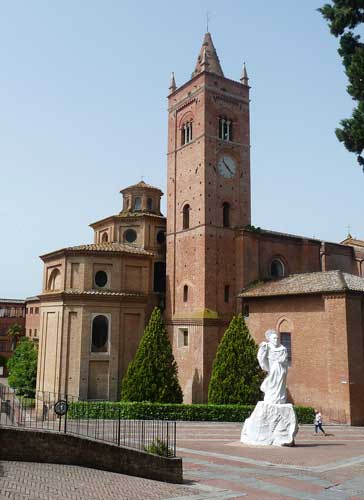
•Abbey of Monte
Oliveto Maggiore. Serena and Claudio, fellow guests at the
B&B, recommended we visit this secluded abbey, and we’re glad we
did. Off one of the rural highways near Chiusure, we followed the signs
directing us to the abbey, which was built in the 14th and 15th
centuries and dedicated to St. Benedict.
From the parking area we crossed a drawbridge that
led to a fortress-like building with a massive square tower. Built in
the late 14th century, it was restored in the 19th century and now
appears a fairly modern complex with apartments, offices, and a cafe.
Beyond, we walked down the hill through the woods a few hundred yards
to the well hidden Abbey with a sculpture of St. Benedict in white
marble in front to welcome us. The abbey complex houses a monastic
library of more than 40,000 works (which was not open to us while we
were there), a pharmacy of herbs and spices, a portico with beautiful
frescos depicting scenes from the life of St. Benedict, a refectory
where the monks dine, and a late Gothic church, later redecorated in
1772.
In addition to a small book and souvenir store, a
wine cellar is located in a lower level accessed from the outside where
locally produced wines are available for tasting and purchase. We did
buy a bottle to share with the rest of the family when we met up with
them again in Rome.
X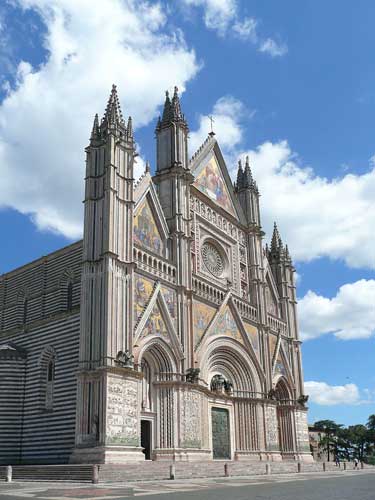
•Orvieto.
Further south we drove just across the border of Tuscany into Umbria to
this dramatic town built on a large volcanic butte. The walls of this
former Etruscan center are of the tufa, making the town virtually
impregnable and strategically important on the road between Florence
and Rome. Thomas Aquinas taught at Orvieto’s studium (a school of
theology, one of the first in Europe) in the 13th century. Along with
Viterbo and Avignon, Orvieto was only one of three papal palaces where
popes could escape conflict in Rome. Over the years, Orvieto was also
the scene of many important meetings of the Curia. Politically the area
was under control of the Catholic Church until 1861 and Italy’s
unification.
The close ties to the Church in Rome helps to
account for the spectacular duomo or cathedral in the heart of this
thriving town (population about 23,000). Pope Nicholas IV laid the
cornerstone in 1290. The green basalt and white travertine striping is
similar to the design of the Siena cathedral which was built during the
same period. The exterior is decorated with friezes and sculptures
representing biblical scenes, huge bronze doors, a large rose window,
and gold mosaics. Equally impressive is the spacious interior
consisting of a nave with six bays and two aisles. The columns are
striped with alternating rows of travertine and basalt, repeating the
pattern of the exterior. The elaborate baptismal font is from the 15th
century. Frescoes by many of the finest artists of the 14th and 15th
centuries contributed to the cathedral’s overwhelming beauty: Giotto,
Fra Angelico, Signorelli, and many others.
Entering the church we were treated to beautiful,
almost ethereal music, sacred but not from the Middle Ages, modern yet
in soft harmony with the setting. The effect was soothing and raised
our tour of the cathedral from an art/ architectural study to a
spiritual experience. It was the only place where we heard music used
to enhance the visit.

•Civita di
Bagnoregio. Probably the most spectacular hill town we
encountered was this tiny collection of stone buildings huddled
precariously on the remains of a volcanic plateau overlooking the Tiber
River Valley. It is connected, literally, to the rest of Italy by a
walking bridge about half a mile long from its former suburb of
Bagnoregio. Today the population is 84 according to one resident with
whom we spoke; we read other estimates that varied from a dozen to more
than 100, depending upon the season of the year. The Italians refer to
it as il paese che muore
(“The town that is dying”) Tourism may help provide a financial
lifeline, but earthquakes and gradual erosion may bring the whole town
crumbling into the valley below.
Civita was the home of St. Bonaventure who died in
the 13th century, but his boyhood home dropped off the edge of the city
well after his death. The town built by the Etruscans over 2500 years
ago was on listed on the 2006 World Monuments Fund’s Watch List of the
100 Most Endangered Sites. Like the glaciers on Mount Kilimanjaro,
we’re glad we saw Civita before it disappears.
We walked slowly through the town, looking down
short alleys and in the few shops and cafes that were open. At the end
of town the cobblestones turn to a dirt path that leads to a shrine at
the mouth of a small cave. Flowers were in bloom almost everywhere and
the streets were spotless. The people of Civita and those who work
there obviously care very much about their town.
•North
and West of Siena
Within an hour’s drive of northwest of Siena are at
least two equally interesting hill towns:
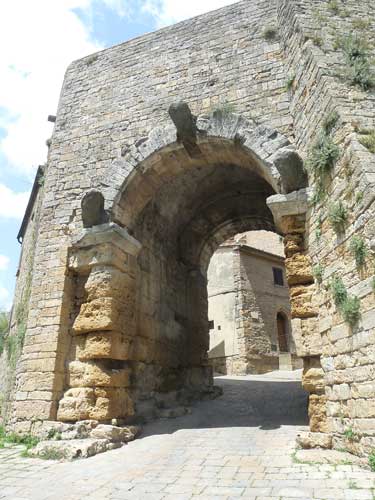
•Volterra.
The approach by car to Volterra crosses a scenic landscape of vineyards
and grassy fields before the road starts its steep, winding 1,000'
climb toward the fortress and the walls that have defended the city for
centuries. Volterra has seen several rulers come and go since it was
founded in the 8th century BCE by Etruscans, who were followed by the
Romans, the Florentines, the Medici family, and the Grand Duchy of
Tuscany until unification in 1861. We entered through the
well-preserved Etruscan Arch built in the 3rd (or 4th? or 8th?) century
BCE. that was saved from Nazi destruction by the citizens of Volterra
(who, it is said, secretly dug up the cobblestones in the road beneath
the arch and filled in the arch to the top to convince the Nazis that
the advancing Allied Forces could not get into the city and there was
no need to destroy the arch. When the Nazis left, the townsfolk
replaced the cobblestones to their original patterns.)
The city is surrounded by high stone walls with a
mighty fortress at one end that marks the start of the uphill walk to
the main part of town to the oldest town hall in Tuscany, the 13th
century Palazzo dei Priori. Signs of the Florentine period are
everywhere (e.g., stone winged lions). The original Cathedral was
destroyed by the Florentines in 1472, and the bishop’s seat was moved
to the present Cathedral soon after. The exterior is a featureless
massive stone wall that gives no hint of the rich decorations on the
interior, much of which was restored in the mid-19th century. Leading
artists from the 12th through the 19th century created a masterwork of
frescoes, paintings, sculptures in the 15 chapels off the nave that
span nearly 900 years of Italian art history.
The presence of the Roman Empire is easy to see in
Volterra. A first century BCE Roman theatre sits just below the
medieval wall. There are clear remains of an ampitheatre seats, and the
marble Corinthian columns are grander than many of the remains of
similar structures seen in Rome. Roman baths were uncovered in the
18th century and date back to the 3rd century CE. They are currenly
being stored.
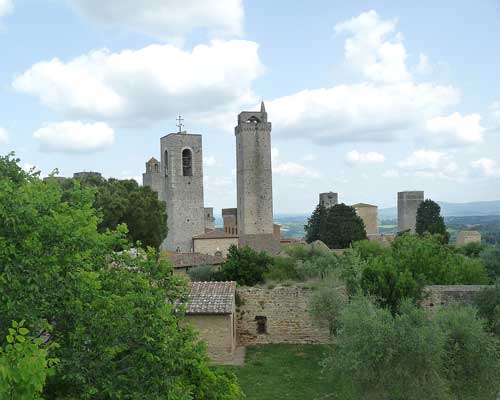
The number of shops in Volterra is blessedly small,
especially compared with other hill towns. Since the town has made much
of its reputation on alabaster objets d’art, it is appropriate that
many stores display and sell alabaster objects, such as the store
of the Societa Cooperativa Artieri Alabastro, a cooperative of
alabaster artisans, where a local artisans show and sell their work.
•San Gimignano.
This medieval hill town is touted by many tourist guides as one of the
Top Ten Places to Visit in Italy! But who would know? It’s true, people
come here by the busloads because outside of town is a massive area for
buses to park and let out their passengers. Most groups come from
nearby Florence, but many also are from other parts of Italy. The
result is a small town of about 7,000, a World Heritage Site, that is
overrun every day with hoards of tourists who clog the streets licking
gelato cones and dashing in and out of the scores of souvenir shops in
a hurry to get back to their bus before it leaves them behind. The best
times to visit this still well preserved Gothic-Roman town is early
morning or evening.
[Note:
UNESCO created the concept of a World Heritage Site to protect
important human or natural resources from extinction or destruction. In
the case of San Gimignano, the town’s status as a World Heritage Site
may be doing more to cause its rapid destruction than help to preserve
it.]
The story of San Gimignano is much like that of
Volterra and other Tuscan hill towns: the Etruscans were followed by
Romans, Florentines, and so on. However, over the years feuds between
Guelphs (who supported the Pope) and Ghibellines (who supported the
Holy Roman Emperor) resulted in a rivalry to see which group could
build the tallest and most tower houses. For two centuries 72 towers
were built up to as tall as 230' until the city council capped the
height of any building to be no taller than the adjacent to city hall
(Palazzo Comunale). Today 14 towers remain creating a memorable skyline
and giving credence to the nickname “Town of Fine Towers.” Visitors can
climb the Torre Grosso (tallest remaining tower at 177') for a great
view of the village and surrounding countryside [Note:
Access to the top of this tower costs €7.50 (US$10.25). There are 218
steps each way and an elevator is not included.]

•Siena
Legend has it that Siena was founded by Senius, son
of Remus of Romulus and Remus fame and is considered by some to be
Italy’s loveliest medieval city. It central plaza, Il Campo, is located
where the Roman Forum used to be when the Empire ruled the area. Today
it’s still a gathering place surrounded by restaurants, cafes, shops,
businesses, and public buildings. It is known world wide as the site of
the famous Palio horse race run twice each summer (see the James Bond
film “Quantum of Solace”).
•The Siena Duomo
was built in the 13th century on the site of an earlier cathedral.
Black and white marble layers make up the exterior walls, a feature of
other churches of the period (e.g., Orvieto Duomo). Sculptures of
prophets and apostles by Giovanni Pisano (who is buried within the
church walls) decorate the lower levels. The huge bronze door was
installed after WW II to replace the original wooden one.
The interior walls and columns of this striking
cathedral continue the striped black and white motif. Busts of popes
and emperors decorate the walls and moldings. The ceiling is painted in
blue with golden stars; Bernini’s gilded lantern in the top of the dome
completes a representation of heaven. Paintings and frescos are by
Donatello, Bernini, and Michaelangelo, among others.
Perhaps the most impressive feature of the interior
is the ornate and magnificent floor of inlaid marble mosaic that covers
the entire cathedral. The sections of the floor represent different
artists, different biblical scenes, and many different techniques and
subject matter. Giovanni’s “Slaughter of the Innocents” is remarkable
for its scope and size and complexity. Some sections are available for
viewing for only six to ten weeks each year and then covered to
preserve them.
In addition to two chapels, Chapel of St John the
Baptist and the Chigi Chapel, the Piccolomini Library is a remarkable
room that features displays of beautiful illuminated choir books. The
frescoes around the room portray ten remarkable events in the life
of Cardinal Enea Silvio Piccolomini, who became Pope Pius II
(1458–1464). The artist, Pinturicchio, is said to have borrowed his
designs from Raphael, who is represented in some of the panels along
with Pinturicchio. The colors in the frescoes appear as fresh as when
they were painted in the early 1500s. The same is true for the ceiling
panels which use subjects from mythology. In all, this is a part of the
Duomo not to miss.
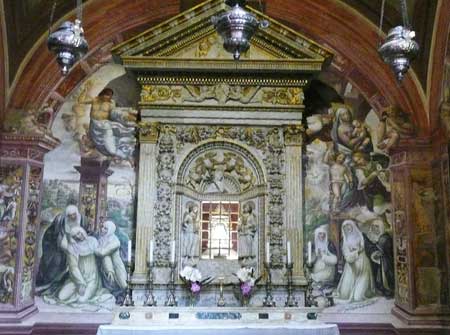
[Note:
A ticket to the Duomo only is €3.00 (US$4.00), but a combined ticket
option for €12 (about US$16.50) permits entrance to the crypt
(not very
interesting); the baptistry
(the bronze and marble font with sculptures
by Donatello and Ghiberti are surrounded by frescos by Vecchietta that
make this small section of the Duomo an important stop on the tour);
the museum
(which includes an opportunity to walk along the top of one
of the outside walls for a panorama of the city), and the Piccolomini
Library.
In all, this is an impressive site and worth at least a half
day to explore.]
•St. Catherine.
We briefly visited the Basilica Cateriniana San Domenico out of plain
curiosity to see the mummified head and the right thumb of one of the
holiest and active women to work on behalf of the church. Saint
Catherine was born in Siena and lived from 1347–1380. During her short
life, she traveled widely encouraging church reform and preaching
repentance and dissuading anti-papal beliefs. She also wrote letters to
political leaders urging peace among the city-states in Italy, and to
church officials, including several to Pope Gregory XI, urging him to
return from Avignon, which he did in 1377. Upon her death, her body
remained in Rome where she died (she is buried in the cemetery of Santa
Maria sopra Minerva across from Bernini’s elephant statue), but her
head was smuggled to Siena and is displayed in a reliquary in the
Church of her Dominican community in her hometown of Siena, and, it is
said that one of her feet is in Venice. This remarkable woman was
canonized by Pope Pius II in 1461.
•Il Campo.
The Piazza il Campo is the main square or public space where people sit
at a cafe and look out at the people wandering across the open area, or
sit on the stone surface, eat their gelato and look at the people
sitting at the cafes. (We did not sample any gelato served up at any of
the highly rated and highly touted gelaterias, one of which boasts they
make the “best gelato in the world.” Others would certainly want to
make the same claim. Let it be said that gelato is king in Siena.)
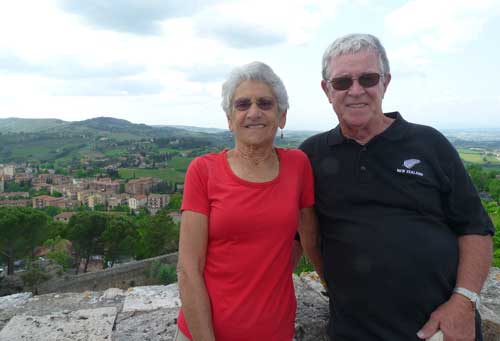
It is fun to imagine what the il Campo is like when
it is transformed into a race track for the Palio Horse Race, held
every July 2 and August 16, a Siena tradition going back to the 17th
century. The central area is packed with spectators who, like those
watching the Indianapolis 500 from the infield, can’t see much of the
race squashed in as they are with 28,000 other people, while ten
horses, representing the 17 contrades (sections or neighborhoods of
Siena) are ridden around the crowd on a temporary track of earth spread
on the square’s brick surface special for the event. Mattresses are
placed against the walls at dangerous corners. More than 33,000 other
spectators pay for bleacher seats or hang out windows and balconies
around the square. It must be quite a scene.
[Note:
If taxis are scarce, the same is true of visitor parking. Watch the
color of parking spaces: yellow means not a chance; blue means pay;
white means free parking. There are not many white lines in Siena, so
planning and timing are critical. Thanks to Valerio, our host at
B&B La Flora, we found a good area of free parking around the
northwest side of the Fortezza (fort) and in the neighboring
residential area. There are many white lines in this area and the walk
to city center is less than a mile.]
•Dining
in Tuscany
We had only a few dinners out while in Tuscany, so
when you see us
don’t ask us many questions about Tuscany cuisine. We probably missed
some amazing dining opportunities, but we tend to eat more simply with
whatever is at hand. We did enjoy an outstanding dinner at the Monalbuccio Restaurant and Pizzeria
not far from Siena. We went at the suggestion of our B&B host
Valerio and with the guidance of our GPS, since the route was
convoluted and the location fairly isolated. The large menu featured,
we are sure, every traditional Tuscan dish available and each
delicious. We ate antipastos (starters), primos (a pasta dish served as
an appetizer; soup or polenta could be ordered instead), secundos (the
main course), contornos (side dishes usually vegetables or salad), and
dolce (dessert). Plus they served an excellent house red and a
cappuccino to finish off the meal. You can read our review at
TripAdvisor.

[Note:
We purchased a chip with maps of Italy for our Garmin Nuvi GPS which we
use when traveling in this country. We could never have had such a
stress-free week of driving without it. We were never lost, always knew
where we were going, which exit to take out of a roundabout, where the
closest gas station was located, where the Monalbuccio Restaurant is
located, etc. Without our GPS, we would have wound up in Croatia. It
was the best $30 investment we made for the entire trip. We should have
had one for our trip last summer to Cornwall and Devon. It would have
made that trip so much more enjoyable. We love maps, we read maps, we
have lots of maps, but we will never travel/drive, especially outside
this country, without a GPS. Our advice: Don’t leave home without it!]
We traveled to Buonconvento for dinner at Restorante Da Mario, a small
restaurant in a non-tourist town at the suggestion of a Nederland
friend who traveled there some years ago and remembered having a good
meal there. We did also: the house red was excellent, the lamb was very
tasty and nicely spiced, the pasta fresh and the roasted veggies just
fine. We’re glad we came and sat with the locals who have kept
this neighborhood restaurant prospering since 1971.
Our B&B host Valerio is also a fine cook and
will serve dinners if guests request them. He will post the menu in the
morning and guests will indicate if they will be staying for dinner (at
8:00 pm). We had two meals there with Serena and Claudio (See photo
above), and enjoyed
Valerio’s fresh made pici, raviolis, and frittatas with roasted veggies
and a selection of sliced cold meats and sheep cheeses. For dessert
each night he served biscotti slices which we dipped in small glasses
of Vin Santo, a very strong, sweet late-harvest wine. Now that’s a
Tuscan tradition!
III. RETURN TO ROME—AND HOME
We returned the car to Eurocar drop-off office in
Siena and walked a few hundred yards to a bus stop where Valerio had
arranged our tickets for us to board the bus to Rome on the edge of
town rather than backtrack to the main bus station in downtown Siena.
The bus ride was comfortable, smooth, without any delays and got us to
Rome in about three hours. The Metrebus
Roma (the Metro) took us to the
Colosseum station, just a short walk to the Hotel Capo d’Africa for a
reunion with Dan, Debra, Griffin, and Julia for one more night before
we left for home. Actually, Griffin left within an hour of our arrival
for his flight to Paris and a train to the southern French city of St.
Jean-Pied-du-Port (probably) near the Spanish border to begin 500-mile
trek on the Camino de Santiago. This traditional pilgrimage to the
shrine of St. Jerome has many roads leading to the town of Santiago de
Compostela in northwest Spain. As of this writing, Griffin had
completed about half the trip. He has a ticket home on July 2, so he
has allowed sufficient time to make the journey.

[The
2003 movie “The Way” starring Martin Sheen tells the story of a father
who makes the trip to gather the remains of his son who was killed in a
freak storm while making the journey. It was filmed on location and
shows the terrain and scenery along the route. It’s an excellent movie
and a moving story.]
We said good-bye to Griff and spent the rest of the
afternoon relaxing and completing our final packing for an early
getaway to the airport for our morning flights home. We gathered on the
rooftop patio of the hotel to enjoy the bottle of wine be brought from
the Abbey of Monte Oliveto Maggiore before walking to our second dinner
at Taverna Dei Contrari, where we were welcomed as though the waiter
and chef truly recognized us.
IV. CODA
It was a perfect ending to a
wonderful trip: Good
wine, good food, good friends. For two weeks we were moved by history
and scenery we would not see anywhere else. Best of all we shared it
with part of our family whom we don’t see often enough and, with the
grandchildren about to embark from college into their adult lives, we
may not see together again for quite a while. We’re lucky parents and a
lucky family to have had this opportunity. We’ll work hard to create
another opportunity in the future.
 •Borghese
Gardens
•Borghese
Gardens
 Our grandson had spent the
spring semester living in Rome studying history, art, architecture as
well as traveling to historic sites from Venice to Sicily. His last day
was May 9, so we tagged along with this parents and sister to celebrate
completion of his studies and take advantage of his knowledge of Roman
history and art. Unfortunately he did not study the language—he is
majoring in Classics and his languages are Latin and Greek—nor did he
have the luxury of spending time in fancy restaurants. As a result, we
stumbled along with gestures and a few key phrases, and confined our
dining choices to surprisingly fine neighborhood trattorias and small
restoranti.
Our grandson had spent the
spring semester living in Rome studying history, art, architecture as
well as traveling to historic sites from Venice to Sicily. His last day
was May 9, so we tagged along with this parents and sister to celebrate
completion of his studies and take advantage of his knowledge of Roman
history and art. Unfortunately he did not study the language—he is
majoring in Classics and his languages are Latin and Greek—nor did he
have the luxury of spending time in fancy restaurants. As a result, we
stumbled along with gestures and a few key phrases, and confined our
dining choices to surprisingly fine neighborhood trattorias and small
restoranti. 


 We went one step further, thanks to our daughter’s
foresight and good planning: she hired a guide, Agnes from England, to
lead our tour of five through the Museums and into the Sistine Chapel.
Agnes works with Context Travel
and she was terrific. She did not show
us everything, but focused on what she thought was most interesting (or
what she knew the most about or what she thought, based upon previous
groups, we might be most interested in.) However, she answered all our
questions about anything we wanted to know. She kept a good pace to
maximize our time (about three hours), had a good sense of humor, and
showed us, we believe, the highlights. It was a good tour and we
recommend this way of getting the most from the experience. You could
opt for a recorded tour (and many people obviously did), but Agnes was
stimulating and provocative in a way a recorded tour can’t be.
We went one step further, thanks to our daughter’s
foresight and good planning: she hired a guide, Agnes from England, to
lead our tour of five through the Museums and into the Sistine Chapel.
Agnes works with Context Travel
and she was terrific. She did not show
us everything, but focused on what she thought was most interesting (or
what she knew the most about or what she thought, based upon previous
groups, we might be most interested in.) However, she answered all our
questions about anything we wanted to know. She kept a good pace to
maximize our time (about three hours), had a good sense of humor, and
showed us, we believe, the highlights. It was a good tour and we
recommend this way of getting the most from the experience. You could
opt for a recorded tour (and many people obviously did), but Agnes was
stimulating and provocative in a way a recorded tour can’t be. 
 The interior is imposing and lavishly decorated; it
compares well with St. Peter’s, though without as many major art pieces
as found in the Vatican. Magnificent larger than life statues of the
twelve apostles by various 18th century sculptors fill niches in the
walls surrounding the nave. Tombs of early popes are placed around the
edges of the nave, the ceiling is beautifully complex and richly
decorated, the patterns in the floor are reminiscent of those in St
Peter’s, and sitting along on the back wall of the altar is the Pope’s
marble throne to be used only by him. The church claims to house two
significant religious relics: the cedar table said to be the one used
at the Last Supper, and a sample of Christ’s blood.
The interior is imposing and lavishly decorated; it
compares well with St. Peter’s, though without as many major art pieces
as found in the Vatican. Magnificent larger than life statues of the
twelve apostles by various 18th century sculptors fill niches in the
walls surrounding the nave. Tombs of early popes are placed around the
edges of the nave, the ceiling is beautifully complex and richly
decorated, the patterns in the floor are reminiscent of those in St
Peter’s, and sitting along on the back wall of the altar is the Pope’s
marble throne to be used only by him. The church claims to house two
significant religious relics: the cedar table said to be the one used
at the Last Supper, and a sample of Christ’s blood. 


 •Borghese
Gardens. This 148-acre park is an oasis of quiet beauty
surrounded by the hubbub of the city. It is used by runners and
bicyclists, folks with picnics or books, and those who simply want to
relax under the shade trees that cover the grounds. Originally a
vineyard, Cardinal Scipione Borghese began developing the garden in the
early 1600s and informally opened it to the public. The city of Rome
purchased the grounds in 1903.
•Borghese
Gardens. This 148-acre park is an oasis of quiet beauty
surrounded by the hubbub of the city. It is used by runners and
bicyclists, folks with picnics or books, and those who simply want to
relax under the shade trees that cover the grounds. Originally a
vineyard, Cardinal Scipione Borghese began developing the garden in the
early 1600s and informally opened it to the public. The city of Rome
purchased the grounds in 1903. 



















